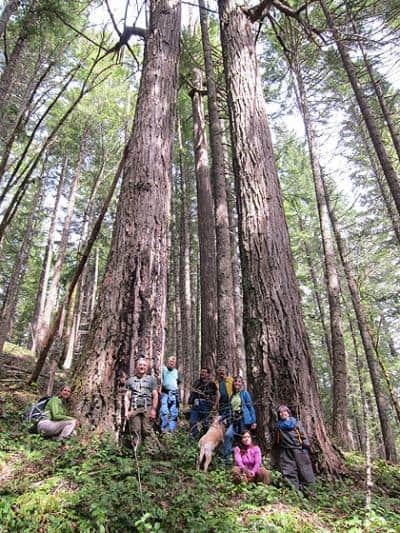
…That [trees] can sequester carbon has been much touted in policymaking circles as one tool to help shrink our carbon footprint; and thus trees seem critical to the larger effort to reduce global warming.
Yet it does not necessarily follow … that we must reforest the planet as rapidly as possible….
Sure: if we had a more complete picture of the variations of potential temperature change across ecosystems and typographies; if we could pinpoint when and where alterations in precipitation will occur; and were we able to calibrate the shifting influence that heat, light, and wet will have on differing soil types, then we might have a clue about what tree species to plant in which biota and at what times.
But we don’t. So to plant trees in hopes that they will survive — and thus increase the odds of us doing so — seems, at best, random.
Take a local analogy. In the scorched aftermath of the Station Fire the U. S. Forest Service feared that the erosive force of coming rainy seasons would strip the burned-over district of its soil. It thus launched an aggressive restoration project. Beginning in April 2011, contract labor planted one million seedlings of an expected three million over five years. The goal was to re-green approximately 11,000 acres of the 160,000 that burned at a white heat during August and September 2009. The Angeles National Forest, or at least a portion of it, would be reborn.
It has not happened. Only about 25 percent of the seedlings dug into charred slopes, cindered meadows, and blackened canyon floors have survived, a mortality rate that has stunned agency foresters. “When we planted seedlings, conditions were ideal in terms of soil composition and temperature, rainfall and weather trends,” one of them told the LA Times. “Then the ground dried out and there just wasn’t enough moisture after we planted.”
The Forest Service has gone back to the drawing board, shrinking the number of acres to be planted and, where possible, switching to tree species that are indigenous to the San Gabriel Mountains.
Critics are unappeased. One of them [mused], “The reality we live in is a Mediterranean climate, and there is just not enough water to create what they have in mind. I do not believe they will succeed because this is Southern California, not rain-drenched Oregon.”
This climatic reality is part of the reason why there has been a very long history of flawed regeneration projects on county and federal lands in the San Gabriels….
The Forest Service has never quite learned L.A. County’s hard-won lesson. Despite what federal foresters long have understood about the low fertility of local soils, mercurial weather patterns, and steep canyon walls, they have repeatedly endeavored to re-engineer the San Gabriels’ ground cover. …
Why this institutional memory has not surfaced to check the Forest Service’s current aspirations to reforest portions of the Angeles is an open question.
More to the point, the agency’s century-long inability to rearrange the San Gabriels’ biota to its liking is a powerful rejoinder to those who so confidently believe that planting trees, indiscriminately and in large number, will help resolve some of the challenges that a climate-changed world is bringing. [most hyperlinks omitted here]
Endnote: The evidence Miller cites is not the only evidence that the Forest Service “never quite learned [its] hard-won lesson.” The Forest Service’s Wyoming Study in the early 1970s came to similar conclusions. In the early 1970s, following a bark-beetle infestation and big clearcuts in lodgepole pine in Wyoming, the Forest Service began a massive re-planting effort. The logging went well. The planting did not. And the very large clearcuts raised controversy, in part fueled by the failed planting effort. The saplings died for the most part, scorched by the sun in the barren clearcuts. Many were planted again, and they too died, as documented in “Forest Management in Wyoming, 1971” (cited here). The Wyoming Study, led in part to the Church clearcutting guidelines that made their way into the National Forest Management Act of 1976. You’d have thought that the Forest Service would have been very wary of future adventures in re-planting. But no.
Now, in Southern California the Forest Service has, once again, wandered into a planting effort that has failed for pretty much the same reasons. Only this time they had a ‘partner’ – the National Forest Foundation — and outside money from “carbon offsets” government subsidies.


